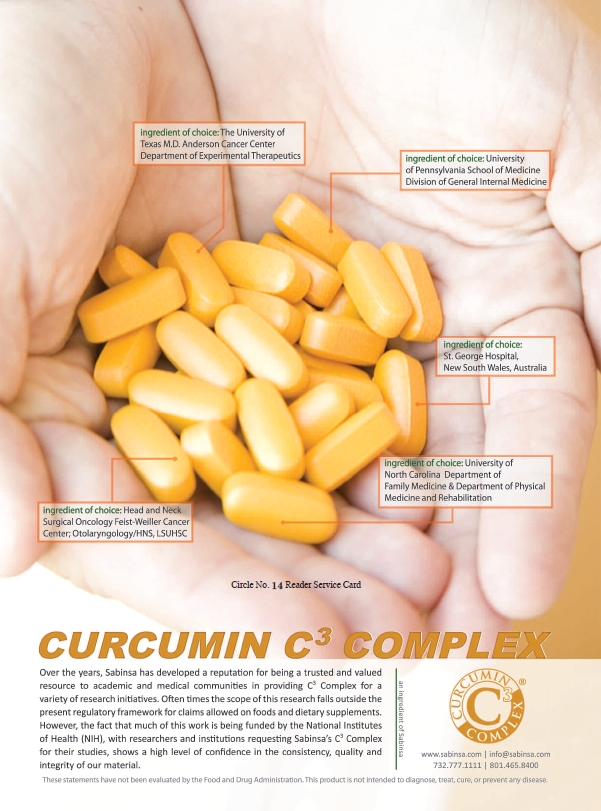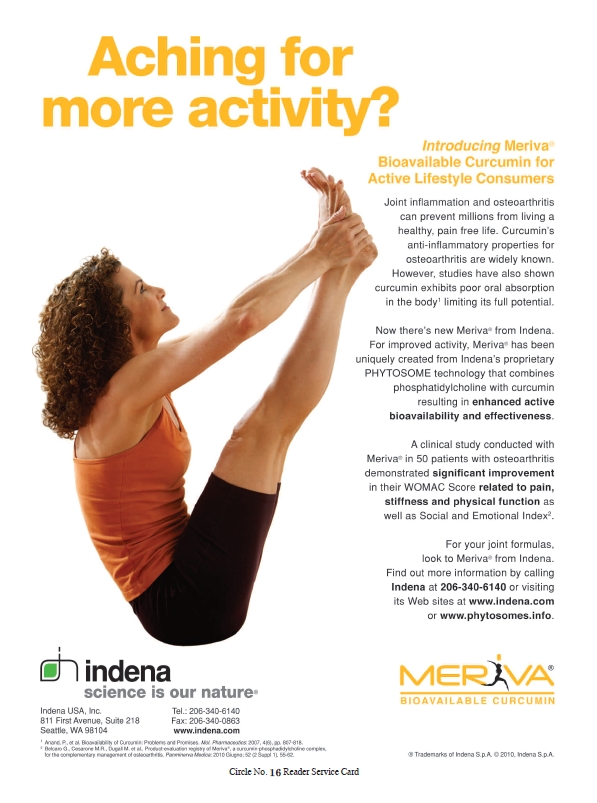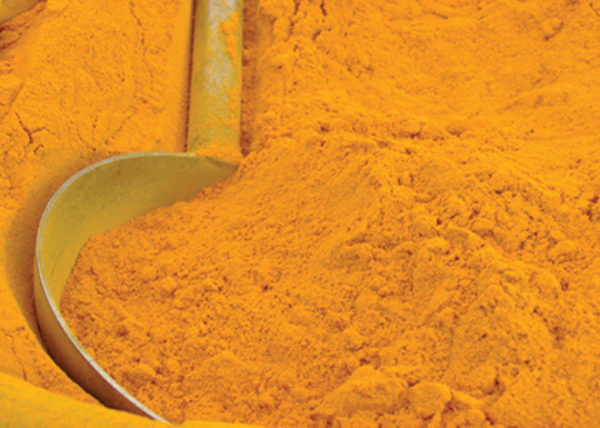Researchers have struck gold with curcumin, a component of turmeric that possesses antioxidant and anti-inflammatory properties. While the distinction is not often made, curcumin is a single phytochemical, and “commercially available curcumin preparations contain a mixture of related polyphenols, collectively referred to as curcuminoids” (1). These plant polyphenol compounds take their job seriously, and have been found effective in maintaining health across a wide spectrum of issues.
Curcumin’s Exotic OriginsWhile American doctors and researchers have studied the effects of turmeric for decades, Eastern Asian and Indian countries have been using turmeric for medicinal purposes for hundreds of years (2). Originating from the rootCurcuma longa in the ginger familyZingiberaceae, curcumin gives turmeric its distinctively rich yellow coloring. Many people who ingest turmeric do receive its natural benefits, but for someone who does not eat the herb regularly, there is another way to take advantage of its antioxidant properties.
In isolating the active ingredient, both a water- and fat-soluble supplement are available for everyday use (3). Its chemical make-up enables curcuminoids to be “single agents,” antioxidants that can be used to support immune systems and other general body issues. Curcumin also “regul
 ates multiple targets,” thus creating its own “multi-targeted therapy” (4). Although research has shown that it works best in certain areas, the supplement can be used for overall cell health in the body.
ates multiple targets,” thus creating its own “multi-targeted therapy” (4). Although research has shown that it works best in certain areas, the supplement can be used for overall cell health in the body.Deflating Free RadicalsCurcumin has been most successful as an anti-inflammatory aid for those with certain diseases, conditions and internal injuries because it regulates the general culprit of inflammation in our bodies called nitric oxide, which can be elevated by levels of radiation or tissue damage (1, 2, 4). As a “pro-inflammatory gene,” nitric oxide can run rampant throughout the body and be the catalyst in many inflammation-induced illnesses (1, 2). Through research, curcumin has been found to help in a range of health issues (5).Rheumatoid arthritis. In a study originally conducted in 2006 that is still under further review in many other research facilities, researchers from the Arizona Center for Phytomedicine Research at Arizona University carefully observed female rats in an experiment involving turmeric and concluded that it did in fact aid the prevention of inflamed joints (6). Two types of curcumin were used: one over-the-counter supplement found in many drugstores that contained 94% of three different active curcuminoids and one “oil-depleted turmeric fraction,” which contained only about 41% of the aforementioned polyphenols.
The over-the-counter supplement distributed more curcuminoids thoughout the body, but scientists saw that the rats who took the turmeric extract “were found to have significantly reduced cartilage destruction and bone mineral density destruction” and had better overall health results (6). In relation to this study, both curcuminoid sources were not as effective when used in rats that had previous signs of inflammation. These results are purely lab-based and do not endorse the use of curcumin as a cure for rheumatoid arthritis.
 Alzheimer’s disease. The mysterious cause of this sad and serious illness has stumped scientists for years until 2009, when the UCLA School of Medicine in Los Angeles, CA conducted a break-through study that involved turmeric and reduction of amyloid beta. Within the research of Alzheimer’s, a certain amount of amyloid plaque has been found in the brains of several deceased patients, causing doctors and researchers to conclude that this could be a “hallmark” of the disease and the cause of the common inflammation of certain brain areas (7). Amyloid beta, the beginnings of this plaque, is naturally found in the brain; curcumin has been found to help regulate this substance before it becomes out of control. The experiment partnered the supplement with vitamin D3, showing “a significant increase in beta-amyloid uptake by the macrophages [microbes that are also a part of the body’s immune system] in 3 of the 6 subjects with Alzheimer’s disease” (8).
Alzheimer’s disease. The mysterious cause of this sad and serious illness has stumped scientists for years until 2009, when the UCLA School of Medicine in Los Angeles, CA conducted a break-through study that involved turmeric and reduction of amyloid beta. Within the research of Alzheimer’s, a certain amount of amyloid plaque has been found in the brains of several deceased patients, causing doctors and researchers to conclude that this could be a “hallmark” of the disease and the cause of the common inflammation of certain brain areas (7). Amyloid beta, the beginnings of this plaque, is naturally found in the brain; curcumin has been found to help regulate this substance before it becomes out of control. The experiment partnered the supplement with vitamin D3, showing “a significant increase in beta-amyloid uptake by the macrophages [microbes that are also a part of the body’s immune system] in 3 of the 6 subjects with Alzheimer’s disease” (8).There were two types of patients in the experiment: Type I (positive responses) and Type II (negative responses). The positive results were typically found in younger patients, though, who had higher scores on a Mini-Mental State Exam (MMSE) previous to this experiment. The plaque in these younger patients was not in an irreversible state, and thus vitamin D and curcumin were still effective in boosting their macrophages’ actions (8). These two supplements cannot be recommended to prevent Alzheimer’s, but they have been found to be useful in inflamed areas of the brain.
Diabetes.Many Americans suffering from complications of obesity have fallen victim to type II diabetes, a disease in which the body cannot produce enough natural insulin (9). Scientists at the Life Science RD Center for Kaneka Corporation in Takasago, Hyogo Japan used two groups of mice (one group that was fed with turmeric extracts in their diets and one group without extracts) to see the difference in their insulin production. They found that the mice that were fed the turmeric had better hypoglycemic activity and made them less susceptible to inflammation (9).
At the Diabetes and Endocrinology Research Center in Columbia University, New York, a similar test was administered to male rats that were already being fed a high-fat diet. When curcumin was introduced to the diet, they saw a significant improvement in the regula
 tion of the rat’s blood sugar levels (10). Although these results are exceptionally motivating, turmeric has still not been approved by the U.S. Food and Drug Administration to cure or treat diabetes.
tion of the rat’s blood sugar levels (10). Although these results are exceptionally motivating, turmeric has still not been approved by the U.S. Food and Drug Administration to cure or treat diabetes.Heart disease. Another common health issue faced by Americans is heart disease. C-Reactive Protein (CRP) is the culprit of inflammation that causes veins to constrict and harden in such a way that blood cannot travel through (11). Curcumin has been found to support “good” cholesterol (or HDL) in the blood, which pushes the bad fat out and prevents the blood cells from sticking together (11). Its properties can help reverse CPR damage, but its supplemental benefits should not be construed to treat someone who already has heart disease.
Not only does curcumin help “good” cholesterol, it also helps fight the “bad” cholesterol—the kind that causes blockage in arteries. In Halle, Germany, a study was conducted at Martin-Luther University in 2007 to understand how curcumin lowers cholesterol levels and how much is necessary to see significant change at a molecular level (12). Their trials showed that even a small amount of turmeric (50 micrometers) can help decrease the production of bad cholesterol.
In another study conducted a year later at Sunchon National University in South Korea, scientists gave lab rats a diet rich in cholesterol and then used 0.05 g/100 g of curcumin to observe its effects. The results showed that it lowered “free fatty acids, total cholesterol, triglycerides, leptin, and HOMA-IR,” and simultaneously “increased levels of HDL cholesterol …in plasma” (13). Its “hypolipidermic effect” reduced the lipid concentration in cholesterol, and therefore reduced its devastating effects on arteries (13). However, it is best to consult a healthcare provider if shoppers are interested in taking the supplement along with any COX-2 or 5-LOX inhibitors.
 Curcumin in Everyday UseIf curry or other foods seasoned with turmeric don’t suit your palate, time-released capsules can still give you the same benefits. While there is no minimum dosage for daily intake, it is common for an average person over the age of 19 to take between 400-600 mg up to about three times a day (3). In the study connected with rheumatoid arthritis, scientists found that “the equivalent dose necessary to be effective in humans would be approximately 1.5 milligrams /day of a portion of the turmeric root that makes up 3% of dried turmeric powder” (6). Recently, scientists have developed and isolated a “curcuminoid complex” that stays active in the bloodstream longer than other curcumin supplements (14). This is because it has greater bioavailability, which means it is easier to digest from your stomach to the bloodstream where curcumin can travel and promote general health in the body. Versions of this complex are available for public use. Other curcumin supplements are also effective, and amounts will vary for different people. Specific information from your health provider about curcumin is readily available.
Curcumin in Everyday UseIf curry or other foods seasoned with turmeric don’t suit your palate, time-released capsules can still give you the same benefits. While there is no minimum dosage for daily intake, it is common for an average person over the age of 19 to take between 400-600 mg up to about three times a day (3). In the study connected with rheumatoid arthritis, scientists found that “the equivalent dose necessary to be effective in humans would be approximately 1.5 milligrams /day of a portion of the turmeric root that makes up 3% of dried turmeric powder” (6). Recently, scientists have developed and isolated a “curcuminoid complex” that stays active in the bloodstream longer than other curcumin supplements (14). This is because it has greater bioavailability, which means it is easier to digest from your stomach to the bloodstream where curcumin can travel and promote general health in the body. Versions of this complex are available for public use. Other curcumin supplements are also effective, and amounts will vary for different people. Specific information from your health provider about curcumin is readily available.It may seem counterintuitive to take something so spicy to help lower dangerous inner-body inflammations, but it may certainly mean a fair pay-off for your customers’ health.WF
References1. W.W. Quitschke. “Differential solubility of curcuminoids in serum and albumin solutions: implications for analytical and therapeutic applications,” BMC Biotechnology. 8:84 (2008).http://www.biomedcentral.com/1472-6750/8/84, accessed October 2011. 2. Linus Pauling Institute, “Curcumin,” http://lpi.oregonstate.edu/infocenter/phytochemicals/curcumin/, accessed October 2011 3. Advanced Health and Life Extension, “Curcumin (Tumeric),”http://www.advance-health.com/curcumin.html, accessed October 2011. 4. Cytokine Research Laboratory Department of Experimental Therapeutics, “Curcumin: The Indian Solid Gold,”http://www.curcuminresearch.org/, accessed October 2011. 5. https://nccih.nih.gov/health/turmeric/ataglance.htm6. J.L. Funk, J.N. Oyarzo, et al., "Turmeric extracts containing curcuminoids prevent experimental rheumatoid arthritis," J Nat Prod.69(3): 351-5 (2006). 7. ScienceDaily: Science News, “Vitamin D, Curcumin May Help Clear Amyloid Plaques Found In Alzheimer's Disease,”http://www.sciencedaily.com/releases/2009/07/090715131558.htm, July 9, 2009, accessed October 2011. 8. L. Zhang, M. Fiala,et al.,"Curcuminoids enhance amyloid-beta uptake by macrophages of Alzheimer's disease patients,"Journal of Alzheimer’s Disease.10(1), 1-7 (2006). 9. S.P. Weisberg,et al.,“Dietary Curcumin Significantly Improves Obesity-Associated Inflammation and Diabetes in Mouse Models of Diabesity,”Endocrinology.149(7), 3549 (2008). 10. T. Nishiyama, T. Mae,et al.,"Curcuminoids and Sesquiterpenoids in Turmeric (Curcuma longa L.) Suppress an Increase in Blood Glucose Level in Type 2 Diabetic KK-Ay Mice,”J Agric Food Chem.28(5), 959-963, (2005). 11. J. McBarron, “Curcumin: The 21st Century Cure,”Imprint. To Your Health Books, 2011: Brevard, NC. 12. D. Peschel, R. Koerting,et al. "Curcumin induces changes in expression of genes involved in cholesterol homeostasis,”Journal of Nutritional Biochemistry 18(2), 113-9 (2007). 13. Jang EM,et al., “Beneficial effects of curcumin on hyperlipidemia and insulin resistance in high-fat-fed hamsters,”Metabolism57(11), 1576-83( 2008). 14. T. Lemerond, “Acute and Chronic Pain,”www.terrytalksnutrition.com, accessed October 2011.
Published in WholeFoods Magazine, December 2011









